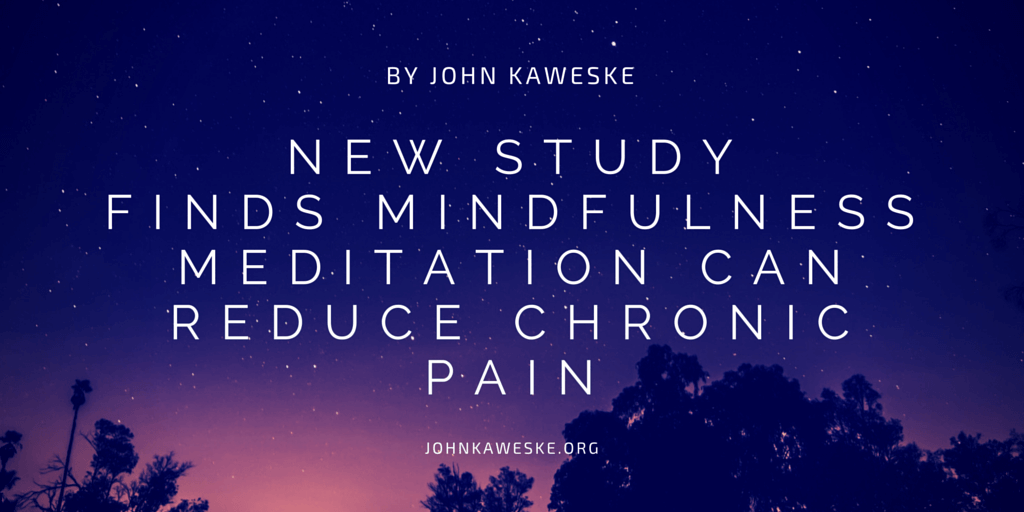If you’re someone that suffers from chronic pain, there may be a highly effective, medication-free option you haven’t explored yet: mindfulness meditation.
Mindfulness based stress reduction (MBSR) was founded back in 1979 by Jon Kabat-Zinn, and recent studies have been demonstrating just how effective MBSR can be.
In a new study published in the Journal of the American Medical Association (JAMA), 342 patients who suffer from chronic low-back pain were divided into two groups. One group was treated with MBSR and the other was treated with cognitive-behavioral therapy (CBT).
CBT patients focused on using strategies that incorporated thought and behavior modification, while MBSR used yoga and mindfulness meditation. All patients participated in weekly workshops for a total of eight weeks before continuing to practice the pain relieving strategies back home.
After all patients used their respective strategies for one year, MBSR proved to be more helpful. The CBT group results capped after 26 weeks, while the MBSR group results capped after 52 weeks.
Mindfulness is thought to be so effective on chronic pain for a number of reasons. First, mindfulness helps bring a different perspective to pain. Instead of having perpetual negative thoughts and anxiety over discomfort, mindfulness meditation allows people to study their pain with curiosity and without judgement.
It also brings a more realistic awareness to the situation, so for example, someone who may think they suffer from pain all day, may realize through mindful meditation that he or she actually feels pain only in certain circumstances, positions, or a predictable number of times a day. Being more aware of the highs and lows of pain can help people manage it.
Another way mindfulness might help with chronic pain is by helping us manage goals and expectations. When we expect pain to go away with a certain practice, exercise, or medication, and it doesn’t, our brain naturally becomes alarmed and frustrated. We start to think things like “nothing ever works,” “this pain is the worst,” “it’ll never go away.” This kind of attitude actually amplifies our subjective view of our pain. This is why mindfulness, which allows us to bring more objective observation to our pain, can be so effective in reducing our own perceptions of chronic pain.
Now that you have a better understanding of how mindful mediation can help you deal with chronic pain, give the following mindful-based strategies a try for yourself:
Body scan – A body scan is an essential part of the MBSR practice. In a seated position with closed eyes, slowly run through every part of your body in your own mind, paying attention to each different part, starting from your feet and moving up to the top of your head. As you check in with each body part, notice the sensations that are present in each part. This will allow you to better understand where your body feels unbalanced. It will also help you keep your pain in perspective: “this is what my pain feels like right now. It may not always feel this way.”
Focus on the breath – We often get so preoccupied with physical or even emotional pain that we neglect to give our minds and bodies a break from the experience. In a seated position with closed eyes, breath in until you fill up every part of your lungs from bottom to top. Hold for 5 seconds, and then breath out slowly until you have completely emptied your lunge. Do this 5 times, moving slowing and paying attention to each moment of the breath. This exercise will not only calm the body and mind, but it will help you escape the ruminating thoughts you may be suffering from about your pain.
Distractions – Distractions come in most handy when your pain is high, especially when breathing exercises aren’t working. Sometimes we need something more engaging that we can completely throw our minds into. Ideally your distraction of choice should get you into a “flow state” that allows you to forget about your own awareness entirely. Read a book, write a story, compose a song, etc. Do activities that require full attention of your thoughts and even make your forget about time itself as you’re doing them. Sometimes the best way to manage your pain is simply by getting your mind off of it.
There’s no medication that will eliminate chronic pain forever, so we need alternative ways to manage pain using our own minds and resources. Chronic pain can easily start to feel like it’s running our lives. Mindfulness meditation can help us re-capture control of our lives.
John Kaweske, Colorado resident, has been meditating for years. He finds that the practice helps him with his focus and ability to lead his entrepreneurial ventures. To learn more about his career and life, please visit his main website.

